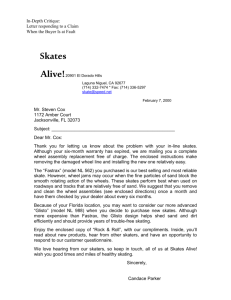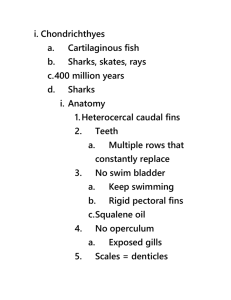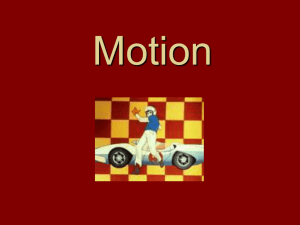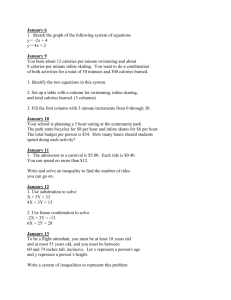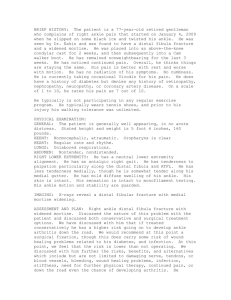14 AUG 2008
advertisement
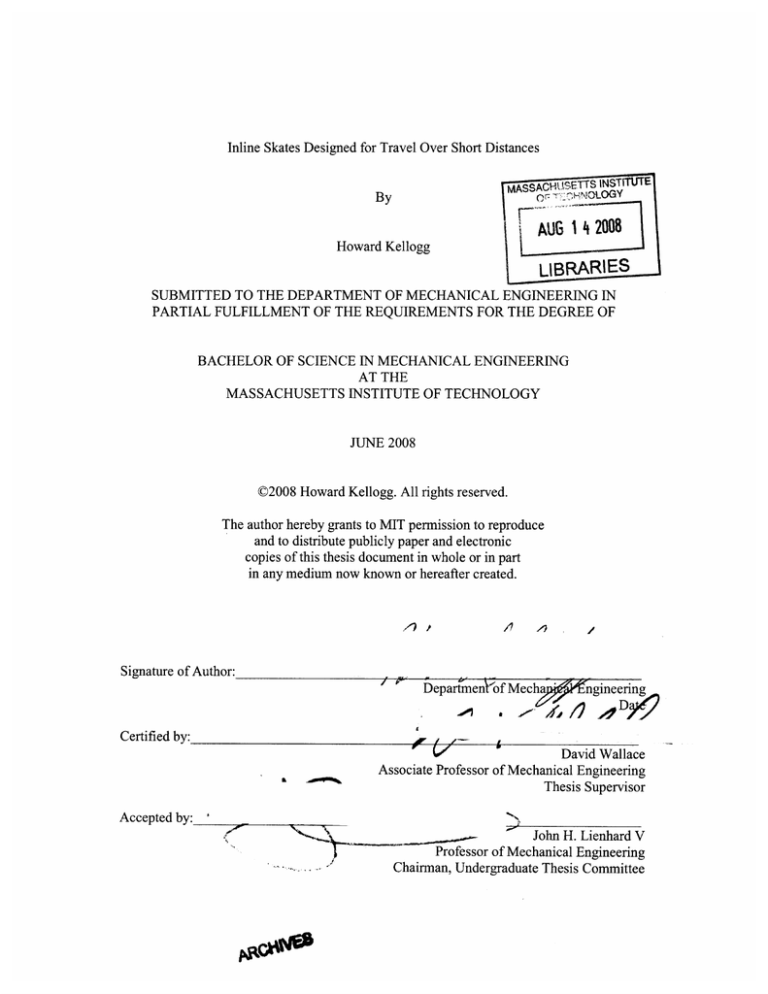
Inline Skates Designed for Travel Over Short Distances MASSACHUtSETTS INSTI 14 2008 AUG Howard Kellogg LIBRARIES SUBMITTED TO THE DEPARTMENT OF MECHANICAL ENGINEERING IN PARTIAL FULFILLMENT OF THE REQUIREMENTS FOR THE DEGREE OF BACHELOR OF SCIENCE IN MECHANICAL ENGINEERING AT THE MASSACHUSETTS INSTITUTE OF TECHNOLOGY JUNE 2008 ©2008 Howard Kellogg. All rights reserved. The author hereby grants to MIT permission to reproduce and to distribute publicly paper and electronic copies of this thesis document in whole or in part in any medium now known or hereafter created. /1 n / Signature of Author: / Certified by: " Departmenhof Mecha . /i ngineenng e D V David Wallace Associate Professor of Mechanical Engineering Thesis Supervisor ,- Accepted by: _ John H. Lienhard V Professor of Mechanical Engineering Chairman, Undergraduate Thesis Committee E Inline Skates Designed for Travel Over Short Distances By Howard Kellogg Submitted to the Department of Mechanical Engineering On May 15, 2008 in Partial Fulfillment of the Requirements for the Degree of Bachelor of Science in Mechanical Engineering ABSTRACT This thesis documents the design process of a new type of inline skate intended to be a viable form of transportation over short distances. Current inline skates are optimized for transportation over long distances but are not useful for travel over short distances because of the time required to put them on and the fact that they are cumbersome to carry. Through a survey and various prototypes, key characteristics have been identified that would make inline skates worth using for short commutes. Characteristics identified include the ability to fit over various types of footwear, the ability to put on at take off the skate quickly and the fold the skates for easy storage when not in use. A working prototype has been developed to demonstrate and verify the first two of these three characteristics. Users tested this prototype and provided feedback. Thesis Supervisor: David Wallace Title: Associate Professor of Mechanical Engineering Introduction When I visited MIT the summer before my senior year of high school I noticed a problem with transportation on campus. As I walked through the campus, I saw bike racks full of bikes and I could only imagine the inconvenience of trying to lock up a bike when one is already late for class. This led me to consider alternative ways to get around campus. Inline skates in their present form were designed by Scott Olson in the early 1980's as a way to train for hockey in areas where there is no ice. Inline skates later became popular for exercise and recreation but have never taken hold as a form of transportation. There are two main aspects of conventional inline skates that make them unsuitable for transportation. The first is effort required to put on and take off the skates. The second is the inconvenience of transporting and storing the skates when the user has reached the destination. The goal of this project was to design inline skates for 'short commutes' of a mile or less. The design consists of a frame that holds the wheels that is attached to the shoe and a means of support for the user's ankle. Discussed below is a history of inline skates, the crucial elements of inline skate design, the development and current prototype as well as user feedback and future development of the project. Background History of Inline Skates The goal in developing inline skates has always been to bring the experience of ice skating to the road. The need for ankle support has been a constant challenge throughout this process. Although we think of inline skates as a modern invention, skates were originally invented in the inline configuration. The early inline skates pictured here in Figure 1 were patented by M. Petitblend in Paris, France in 18191. Figure 1 The first patented inline skate invented by M. Petitblend in Paris, France in 1819. The inline skate was first patented in the United States by Reuben Shaler in 18602. These early inline skates were difficult to ride because, among other things, they lacked ankle support and brakes. It was the lack of ankle support that kept the skates from becoming popular. In 1866 James Plimpton patented the rectangular truck wheel configuration that we think of as 'Roller skates' 3 . Roller Skates were developed in response to the lack of ankle support in the original inline skates. As mentioned before, it was not until the 1980s that Scott Olson developed the rigid boot that provided adequate ankle support for modem inline skate form factor. Although there have been a number of patents that make minor improvements, there have been no fundamental changes in inline skates since that time. It is the developments in ankle support have made it possible to have the experience of ice skating to the road. Informal observation on MIT's campus was the basis for a more in depth investigation of the transportation landscape. The specific aim of this investigation was to determine the reasons that people don't use inline skates for short commutes. A survey was conducted to get this data as well as gauge market interest in a product that would bring inline skating to transportation in short commutes. College students were chosen for the survey because they represent a common user of forms of transportation for short commutes. Because many college students live on campus they have daily 'short commutes' both from campus housing to class and between classes. The survey included students from 9 colleges and universities in the Boston area, most of which have a centralized campus and where majority of students live on campus. A reproduction of the survey is attached in Appendix A. Of the 60 people surveyed, 80% knew how to inline skate, but only 23% currently own inline skates. It can be reasonably assumed that anyone who knows how to inline skate owned a pair at one point. A majority of individuals had inline skated in the past but did not continue into college. It would appear that a majority of college students do not see inline skating as a good way to get around campus. The survey also provided insight that verified assumptions about why this is the case. The data from the survey can be visualized in graphs in Appendix A, Figures 1 through 4. A Pugh chart is used here (Table 1) to compare various forms of transportation that are present on college campuses with respect to various attributes. In this method one item is selected as a baseline and given values of zero in each category, each attribute and all other items are judged with respect to the first item. In this case the bike has been chosen as the baseline because it sparked the comparison. Skateboards, push scooters and inline skates were considered as possible replacements to bikes. The forms of transportation are compared with respect to how easy it is get on and off the item, how easy it was to park or carry the item when not in use, the speed of the item and the skill required to use the item. Table 1 compares three existing forms of transportation to a bike with respect to four attributes. These categories have been weighted to more accurately reflect the relative importance of each attribute. The 'Proposed' form of transportation is the Inline skate that has been designed for transportation. Attribute Easy On/Off Easy to Park/Carry Skill needed Bike Scooter Skateboard In-line Skates Proposed Multiplier I 0.0 1.62 0.68 -1.85 1 -0.5 0.0 1.94 3.26 2.36 2 3.5 0.0 -5.19 -4.86 -3.15 -3.15 3 0.0 0.56 -0.61 -0.2 -0.2 0.5 -1.1 -1.5 -2.8 -0.4 It is common to weight different categories in a Pugh chart according to their importance. The Pugh chart above has been weighted with multipliers that reflect their value. For instance, the speed of each form of transportation has been multiplied by a factor of three because of its importance in short commutes. The ease with which each can be carried has been multiplied by a factor of two because parking a bike is an unattractive quality that was a catalyst for this concept. Informal observations of students traveling on the MIT campus confirm the data represented in the Pugh chart. Both skooters and skateboards are seen less frequently on campus than bikes. It is very rare to see someone inline skating on campus along the river as a form of transportation. On the other hand it is not rare at all to see people on inline skates along the river for recreation. This would reinforce the fact that current inline skates are designed primarily for recreation and not transportation. The data in the survey provides a quantitative description for why inline skates are so inconvenient to use for short commutes. The survey data indicated that collectively, college students have a good understanding of the relative speed of various forms of transportation. Although scooters are very convenient to operate, their small wheels make them inefficient and not much faster than walking. A scooter coasting down a 7% grade hill will go 5mph compared to the average human walking speed 3mph 4. This is a meager speed increase, especially compared to an average of 15-20mph biking speed. Skateboards are faster than push skooters with an estimated average speed of 5-7mph and are easily portable when not in use. The major drawback of a skateboard is that using it requires a level of skill that a majority of people are not willing to develop. The final form of transportation considered was inline skating. Inline skating has a higher average speed than both skateboards and scooters at 9-12mph but they are cumbersome to put on and take off. There are two novelty items that are worth mentioning. First, the Sketcher 'Heely' which as become very popular among children. In a study of over 800 boys and girls age six to eleven Heelys ranked in the top ten most popular items of 20075. The Heely is a shoe with a small wheel that protrudes from the bottom of each heel. Because there are only wheels on the heel and not on the toe the wearer can choose to walk or glide by balancing on their heels. To propel themselves forward the rider must get a running start and then glide. It should be noted that the rider cannot walk completely normally when wearing Heelys. The other novelty item is the 'Strap-on roller Heel skate'. This product basically allows the same functionality of Heelys to be applied to normal shoes. Two wheels are attached on either side of the heel of the shoe. This product does not necessarily hinder normal walking because it can be removed when the user wants to have a normal waking experience. Like Heelys, this product requires a running start to propel it. One of the advantages of this product is that the two-wheels-per-foot design is more stable. In addition, the wheels are larger because they don't have to fit under the heel. This is a benefit because larger wheels roll more efficiently. These Strap-on heel rollers are faster than walking but slower than a push skooter. Because of the lack of significant speed both the strap-on heel rollers and Heelys would be considered novelties and not viable forms of transportation, even for short commutes. Skate Design: Inline skates have basically remained the same since their reintroduction in 1980s. The fact that there have been no major changes indicates that they work well. It is important to understand what makes inline skates work so that one can make changes without loosing functionality. Ankle support is the key to any inline skate. The term "Inline" refers to the fact that the wheels are oriented in a strait line along the axis of the foot. Because the wheels contact the ground along a line they are unstable. Whenever the body weight is not directly over that line there is a torque that tends to make the skate fall over unless a restoring torque is applied. This restoring torque is applied by the muscles in the ankle. If the ankle has to do all this work alone it is both exhausting and greatly increases the danger of ankle injury. A restoring torque need only be applied if the body weight is able to shift away from the line where the wheels contact the ground. Ice skates and current inline skates deal with this problem by constraining the ankle within the boot, not allowing the ankle to bend even if there is a large torque applied to it. Figure 2 provides an illustration of the need for ankle support. 7 Figure 2 Illustration of the need for ankle support. There is a torque created by the person's bodyweight not being directly over the center of the wheels. The support takes this load off of the ankle and transfers it to the structure of the leg which is much better equipped to handle it. For instance if a heavy man of 192 lb (heaviest 97.5 percentile American male) 6 has all of his weight in one skate and that skate is tilted 200 from the vertical (see diagram) a torque of 15.56 N-m is created at the base of the ankle support. This torque must be counteracted either by the strength of the person's ankle or the structure of some ankle support. With greater amounts of skill and ankle strength a skater can use inline skates without ankle support because they are very careful to always keep their weight over the centerline of the wheels. For all practical uses, ankle support is necessary for the use of inline skates. It is ankle support that has driven the development of all skates throughout history. Conventional inline skates use large rigid boots that are attached to the wheels. The reason for such a robust boot design is to make the skate an extension of the leg, removing almost all of the flexibility that the ankle allows. Although there are layers of soft tissue and padding between the structure of the human bone and the rigid structure of the skate boot the skate feels like an extension of the user's leg. It is essential to the rider's feeling of stability and safety that the structure of the leg bones be securely connected to the wheels. One of the goals of these new skates is that they accommodate a wide variety of footwear. This adds another large layer between the two structures that needs to be connected making the job of supporting the ankle more challenging. At the same time it is important that every bit of structure on the skate that is not absolutely essential be removed to make the skate as light and compact as possible. The goal is to remove material without loosing the functionality that the boot provides during skating. The main function of the boot is to rigidly attach the wheels to the leg by removing most of the freedom of motion of the ankle. There are a number of new structures that could replace the boot; one should be selected that uses less material and facilitates folding for storage. These three essential parts are a platform, a means for keeping the shoe constrained with respect to the platform and a means for supporting the ankle. Although the boot performs all of these tasks, it does not do it efficiently. The proposed design must have greater structural efficiency. Design Development The first prototype of this concept was made during the summer of 2004 before I entered MIT. It was very large and heavy and it did not work very well. A great deal was learned about the need for ankle support and fully constraining the foot. The design initially had one wooden support that connected the base behind the heel to a single "C" shaped half circle that fitted to the back half of the leg just below the calf (Picture in Appendix B Figure 1). A strap closed the loop around the leg attempting to support the angle. During use it was learned that both the single wooden support and the single wooden 'C' were not enough to support the ankle. A second version of the wooden skate included two parallel supports from the base at the back of the heel to two wooden C's stacked on top of one another. This configuration proved much more rigid but the foot and leg were still allowed to move inside the supports giving it a loose and uneasy feel. This feeling stemmed from both a lack of padding at the ankle and a lack of constraint of the heel at the base. The greater the distance between the platform of the skates and the ground, the more unstable the system is. This will be referred to as the instability force. The higher up on the ankle the ankle support is the greater restoring force can be applied to the system, counteracting the instability force. In an effort to make the system more stable efforts were made to reduce the height of the platform. The height of the platform is conventionally governed by the height of the wheels. It is desirable to have large wheels because the skates can travel faster with larger wheels. Larger wheels will roll smoother than small wheels because they are less affected by road noise. This smoother rolling translates into higher speeds. Where the need for speed increases the size of wheels and raises the height of the platform, stability pushes back and limits the height of the platform and the size of the wheels. This balance was bypassed in the new design by reducing the number of wheels to two and moving them in front and behind the platform. This allowed the platform to drop below the diameter of the wheels. After building a prototype that had a platform lower than the center of the wheels and testing it two valuable lessons were learned. First, the height of the platform had a smaller than expected benefit for stability. The marginal benefit of lowering the platform is outweighed by the fact that the sides of the platform would graze the ground when the skate was tilted. Another unexpected side effect of lowering the platform was the fact that the wheelbase had to be lengthened. This made turning the skates much more difficult for everyday users that are not used to speed skates. As a result of these insights, the novel platform design was abandoned and focus was diverted to the design of more adequate ankle support. Many initial ankle support designs failed because they focused only on attaching a rigid support to the ankle not taking into account that the heel is free to pivot. This lack of constraint lead to the heel sliding back and forth between the uprights of the ankle supports. Initially it was thought that simply increasing the friction between the heel and the base would be enough to keep the heel in place. Later a second set of pads was added to the uprights below the ankle joint on either side of the foot. It is important that these new pads do not press on the bone that protrudes from the ankle joint. To avoid the need for adjustment, a location was selected for the pads that can accommodate the various shoe sole thicknesses and the variance in human joint height. There is a relatively little change in the height of the ankle joint among human. That difference is 0.5" between the highest 97.5 and the lowest 2.5 percentile. The average thickness of shoe soles range from 0.75" to 1.5". These heights combine to form a vertical range of 1.25" where the protruding bone of the ankle joint could be located for any given set of user and shoe. This range was taken into account in the vertical placement of the pads on the uprights such that they don't press against the joint bone. Figure 3 illustrates this need for two sets of pads to fully constrain the foot within the ankle support. Figure 3 shows the placement of an additional set of pads just below the ankle that fully constrain the foot. When supports contact the get only at the top the leg is free to rotate about that top support. Current Prototype Figure 4 Images of the current prototype is shown configured both riding at left and mount/dismount at right. At right the bar that connects the bottoms of the support uprights is highlighted. The current state of prototype development (above in Figure 4) includes two of the three functional requirements outlined earlier. The current prototype is usable with a wide range of footwear and is easy to put on and take off, but it does not fold up for easy storage. The prototype was constructed from aluminum sheet metal that was cut, folded and bolted together. Below is a diagram of the current design. The key feature of the current prototype is a brace that holds the ankle support rigidly in place during use. It allows the uprights to rotate away from the ankle making it easier to put on and take off the skate. One of the challenges that has been present throughout the development is the balance between having the ankle support be rigid and also easy to remove. Because the uprights are located on the left and right side of the ankle it is helpful for getting the skates on and off if they can pivot away from the leg. The problem with that motion is that it is also the direction from which the supports are loaded during use. Therefore any mechanism that allows the uprights of the ankle support to pivot during mount and dismount must also counteract large loads. The mechanism that was developed in the prototype is shown below in Figure 5. Figure 5 Illustration of how the ankle supports pivot away from the leg to make it easier for the user to get their foot in or out of the skate. When the bar is pressed down by the users foot, the uprights of the ankle support are forced to swing up and lock into place. The uprights are free to pivot outwards making it easy for the foot to get into the skate. The bottoms of the two uprights are connected by a bar that presses down to the level of the base by the foot when it comes into place on the skate. As the bar is depressed the uprights are pulled down through a channel that forces them to rotate up to their upright position and lock in place, constraining the ankle. After the top and toe ratchets straps are tightened the rider is ready to go. The ratchet straps used in this prototype are made by Burton for their snowboard bindings. To remove the skates the user first removes the quick release ratchet straps then lifts up the heel. Pulling upwards on the ankle supports when there is no downward force applied by the heel causes them to slide up. As the uprights of the ankle support begin to slide the clamping effect on the ankle is released and they rotate away from the ankle allowing the foot to leave the skate effortlessly. This design not only negotiates the balance between flexibility and rigidity of the ankle supports but it is easy to operate. The nature of the mechanism does much of the work of clamping and releasing the supports for the user. Another effect of this design is that unlike normal inline skate boots, the ankle support is fully rigid with no degrees of freedom. Normal inline skate boots have a small degree of freedom that allows the ankle to bend slightly when the knee bends. Even though the ankle supports in this prototype do not move at all, the ankle is free to move slightly. In this design the freedom for the ankle to move does not come from the support moving, but from compliance of the padding at the top of the ankle. A greater bend in the knee is only necessary when the skater wants to brace for a large push. This motion is much more common in high performance speed skating. The small amount of bending that the skates allow is sufficient for users who would be using the skates for short commutes. In an effort to reduce the weight of the skates there was a push to remove unnecessary material. Some material was eliminated by minimizing the surface area of the base on which the shoe rests. The boot in current inline skates must evenly support the soft flesh of the foot because it replaces the support normally offered by footwear. Because this design includes the footwear, the base of the skate need only support the sole of the shoe which in turn supports soft flesh of the foot. Where standing on the frame of the skates barefoot might be uncomfortable, the user's footwear evenly distributes the force throughout the surface of the foot. The current prototype has been tested with various forms of footwear to determine whether or not a more supportive frame is needed. After testing it appeared that the least supportive footwear that this design can accommodate is flip-flop sandals. Below Figure 6 shows how the frame supports the sole at only the necessary locations. Figure 6 Overlay of a footprint on the frame that supports the sole of the shoe. Material is saved by not supporting the entire sole of the shoe, but rather supporting key portions of the sole and relying on the structure of the sole to transfer support to the foot. Users of the current prototype indicated that it was either just as, or slightly less stable than current inline skates. Users verified that in general the skates were able to accommodate the predicted shoe size range. It should be noted that the wheelbase should be slightly lengthened to because users with shoes sizes in the top 97.5 percentile push the limits of the wheelbase. This takes away from the feeling of stability the user feels. Tests with users revealed a need for some method for better defining where the foot should be located on the skate. The base and the ankle support makes sure that the foot is in the middle of the skate from left to right, but there is nothing that makes sure that the foot is not too far forward or too far back. Future Development The current prototype functions primarily as a proof of concept and a validation of several parts of the design. There are still aspects of the design that have yet to be developed and tested. The first of these future developments is the final of the three fundamental characteristics of skates that are designed for transportation. To reiterate, those characteristics are the ability to accommodate most shoes, easy to put on and take off and the ability to be folded up for convenient storage when not in use. There are preliminary designs that would allow the ankle support to fold down parallel to the main base. The current ankle support works well because it provides a rigid connection to the base. And modification that would allow the ankle support to fold would need to preserve the rigidity that is required for use. The most intuitive way to incorporate folding is to simply add a hinge with a lock that allows the ankle support brace to rotate down with respect to the base of the skate. This method of folding may allow for the introduction of a beneficial degree of freedom that the ankle support does not currently have. As mentioned earlier there is benefit to allowing the ankle to bend forward a small amount. One of the potential problems with this design is that any lock would need to keep the hinge from rotating when would have to withstand a large load. The ankle support has to be rigid in two axes, one that goes horizontally through the heel and one that goes along the length of the foot. This folding design would have the ankle support rotate about one of these axes. It would be better to have the folding mechanism disengage in a direction that will not experience any large loads under normal use. The other issue with simply folding the ankle support brace pivot down is the interference between the uprights of the ankle support and the front foot strap. Being of equal width one would need to move out of the way of the other for the ankle supports to fold fully down. Although other folding mechanisms that are being considered, but a solution that is both robust and elegant remains to be found. Another design issue that remains to be improved is the ankle support clamp/release mechanism. Most of the time the body weight pressing down on the bar under the heel keeps the uprights pulled down into their locked position. When ever the foot is lifted up the small upward force is counteracted by friction in the channel that the uprights slide in. Future versions would need a simple locking mechanism that holds the uprights down when the foot pulls up off of the base of the skate. Because these forces are small the lock would not need to be very strong. There is a great deal of work that needs to be done in design for manufacturing. It will be possible to focus on design for manufacturing only after the details of the folding mechanism are developed. Even at this point in the process various manufacturing processes are being considered such as injection molding, stamping, bending and possibly aluminum extrusion. An interesting feature of the current prototype is that the skates are symmetrical. This means that each skate can be worn just as easily over a left or a right shoe. The reason behind this feature is to remove one of the steps in the process of putting on the skates. It is not necessary to identify which skate is which because they are the same. It remains to be see if this lack of chirality will cause any problems for use, will be accepted by users and whether or not there are any quantifiable benefits to the usability of the skates. If it is possible to carry this feature through later developments of the design there are a number of possible benefits. First, it would simplify manufacturing by reducing the number of different parts. There could also be benefits to maintenance and service by not having to keep left and right replacement skates in stock. A survey that was conducted with 60 college student also included some preliminary market research. The survey found that about 82% of college students believe that there is a market for a more convenient version of inline skates. Furthermore, about 50% expressed interest in purchasing such a product and indicated that they would be willing to pay on the order of $50 for such a product. Of the students that indicated an interest in purchasing the skated, 70% cited transportation as a reason for buying them. Future surveys would not be limited to college students and would a larger sample. Future surveys would aim to gather more concrete market data by having a more developed prototype and more data to present. Concluding Remarks Based on the research conducted it is clear that the full potential of the inline skates in transportation has not yet been realized. The concept developed here works toward streamlining the process of getting inline skates on and off as well as making them more convenient to carry. Users agree that skates similar to the current prototype can be a viable option for traveling short distances. The prototype was very effective at verifying the benefits of the concept as well uncovering attributes that still need to be developed. The further development of this concept as a product will be appreciated by individuals especially in urban areas who would skate for transportation if it were convenient. Reference 1 Inline Skating Resource Center (ISRC), http://www.iisa.org/resources/history.htm 2 Shaler, R. USPTO, Patent No. 28509. May 1860. 3 Plimpton, J. USPTO, Patent No. 55901 June 1866. 4 Wikipedia, 5 Zwiers, http://en.wikipedia.org/wiki/Walking N. Playthings, The Business of Play. Jan 1, 2008. http://www.playthings.com/article/CA6521730.html 6Dreyfuss, H. Humanscale 7/8/9. p. 2 8 -2 9 . Appendix A kelloggs@mit.edu Survey 1. Age: 2. School: 3. Background (circle): technical non-technical 4. Do you know how to in-line skate: Y / N 5. Do you own in-line skates: Y / N Compare these forms of transportation to a bike: 6. How easy it is to get on/ get off of theses forms of transportation? Much harder than bike same as bike Much easier than bike Push Skooter 4 5 7 Skateboard 4 5 7 In-line skates 4 5 7 7. How easy is it to park/store these forms of transportation? Much harder than bike same as bike Much easier than bike Push Skooter 1 2 7 Skateboard 1 2 7 In-line skates 1 2 7 8. How fast are these forms of transportation? Much slower than bike same as bike Much faster than bike Push Skooter 1 2 3 4 7 Skateboard 1 2 3 4 7 In-line skates 1 2 3 4 7 9. In general how much skill is needed to use these forms of transportation? Much harder than bike same as bike Much easier than bike Push Skooter 1 2 3 4 5 Skateboard 1 2 3 4 5 In-line skates 1 2 3 4 5 (Survey Continued on Reverse) 6 7 10. Is there a market for a more convenient version of In-line Skates: Y / N 11. Would you buy them: Y / N 12. How much would you pay for them: $ 13. Why would you buy this product? (check all that apply) o Novelty o Transportation o Recreation Easy to Get On/Off compared to Bike Skooter m Skateboard El In-line Skates Ua o o. 20 4) W) M 0r r- to, -2 -3 Harder -1 0 1 2 3 Easier Figure 1 Visualization of survey data from question 6. Results indicate strong opinion that inline skates are harder to put on and take off. Skateboards have mixed results, this could be due to the fact that people who know how to skateboard see it as much easier than a bike while people who do not know how to skateboard feel that it is much harder. Easy to Park/Store comared to Bike 3 2 1 0 -1 -2 -3 El In-line Skates 0 Skateboard MSkooter Easier Harder Figure 2 Visualization of survey data from question 7. There seems to be universal agreement that all three of these forms of transportation are easier to park or store than bike. This reinforces the need for an alternative to biking for short commutes. Speed compared to Bike U Skooter l In-line Skates = Skateboaard ---------- ------------- l- -3 | -2 Slower -1 41 _~|1 _ 0 C _| IN 1 Faster Figure 3 Visualization of survey data from question 8. Although all of these are seen as slower than bikes, the inline skate in identified as the fastest of these alternatives to bike. These results show that college student have an accurate understanding of the relative speeds. Skill requiered compared to Bike U Skooter -3 N Skateboard -2 More -1 0 lIn-line Skate 1 2 J 3 Less Figure 4 Visualization of survey data from question 9. Although this data does not provide a strong correlation, it seems to indicate that people feel skateboarding is harder than biking, skooters are easier than biking and inline skating requires about the same level of skill as biking. Appendix B Figure 1 Initial wooden prototype with reinforced ankle support.

